We have given these Class 12 Biology Important Questions Chapter 14 Ecosystem to solve different types of questions in the exam. Go through these Class 12 Biology Chapter 14 Important Questions, Ecosystem Important Questions & Previous Year Questions to score good marks in the board examination.
Class 12 Biology Chapter 14 Important Questions Ecosystem
Question 1.
How does a detritivore differ from a decomposer? Explain with an example of each. (Delhi 2015C)
Answer:
Difference between detritivores and decomposers is as follows
| Detritivores | Decomposers |
| The organisms which feed on detritus and break them into small particles, e.g. earthworm. | The organisms which result in enzymatic breakdown of complex organic matter into inorganic substances, e.g. |
Question 2.
How is ‘stratification’ represented in a forest ecosystem? (Delhi 2014)
Answer:
The stratification, i.e. the vertical distribution of species at different levels in a forest ecosystem. It can be represented-as
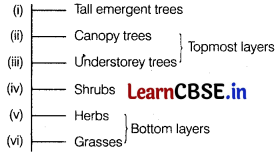
Question 3.
What does ‘R’ represent in the given equation for productivity in an ecosystem?
GPP – R = NPP (All India 2014C)
Answer:
In the given equation for productivity in an ecosystem, GPP – R = NPP. ‘R’ represents the energy utilised by plants or producers in respiration. It is also referred to as respiratory losses.
![]()
Question 4.
Mention any two reasons, why the primary productivity varies in different types of ecosystems. (All India 2014C)
Answer:
The primary productivity varies in different types of ecosystems because
- It depends upon plant species (producers) of a given ecosystem and their photosynthetic capacity.
- It is dependent on various environmental factors, availability of nutrients.
Question 5.
Write the equation that helps in deriving the net primary productivity of an ecosystem. (Delhi 2013)
Or
How is the net primary productivity of an ecosystem derived ? (All India 2012C)
Answer:
Net Primary Productivity (NPP) is the weight of the organic matter stored by the producers which is available to heterotrophs for consumption. It is equal to the rate of organic matter produced during photosynthesis. Gross Primary Productivity (GPP) minus respiratory losses (R) yields NPP, i.e. NPP = GPP – R.
Question 6.
Why are green algae not likely to be found in the deepest strata of the ocean? (All India 2013)
Answer:
Green algae survive by utilisation of food synthesised by themselves through photosynthesis. At deepest layer in ocean, light is absent. So, photosynthesis does not take place and hence, green algae are not likely to be found in deep strata of ocean.
Question 7.
Write a difference between net and gross primary productivity. (All India 2011)
Answer:
Difference between NPP and GPP is as follows
| Net Primary Productivity (NPP) | Gross Primary Productivity (GPP) |
| It refers to the biomass/organic matter available for the consumption to heterotrophs, left after some respiratory losses | It is the rate of production of biomass/organic matter by producers during photosynthesis. |
Question 8.
Write the relationship between productivity, gross primary productivity, net primary productivity and secondary productivity. (All India 2019)
Answer:
The rate of biomass production is called productivity in term of gm-2 yr-1 for an ecosystem. It can be divided in Gross Primary Productivity (GPP) and Net Primary Productivity (NPP). GPP of an ecosystem is the rate of production of organic matter during photosynthesis. NPP is the available biomass for the consumption of heterotrophs (herbivores and decomposers). Secondary productivity is defined as the rate of formation of new organic matter by consumers.
Question 9.
How does the dead organic matter get decomposed in nature? Explain. (All India 2012C)
Answer:
In nature, the decomposer organisms like bacteria and fungi act on the dead organic matter and decompose it by relearing various digestive enzymes.
The process of breaking down of complex organic matter into inorganic substances like CO
2
, water and nutrients by bacteria and fungi is called decomposition.
Question 10.
Describe how do oxygen and chemical composition of detritus control decomposition. (Delhi 2011)
Answer:
Effect of oxygen The decomposition of detritus is largely an oxygen requiring process. Most of the decomposers (bacteria and fungi) are aerobic organisms. They require oxygen for their cellular activities while acting on dead organic matter.
Effect of chemical composition Decomposition rate is slower, if detritus is rich in lignin and chitin. It is quicker if detritus is rich in nitrogen and water soluble substances like sugars.
Question 11.
Describe the inter-relationship between productivity, gross primary productivity and net productivity. (All India 2017)
Answer:
The rate of biomass production is called productivity. It is expressed in terms of g
-2
yr
-1
or (kcal m
-2
) yr
-1
.
Productivity of an ecosystem can be categorised as primary and secondary productivity.
Primary Productivity (PP) is the amount of biomass or organic matter produced per unit area over a time period by plants during photosynthesis. It can be divided into Gross Primary Productivity (GPP) It is the rate of production of organic matter during photosynthesis. A considerable amount of GPP is utilised by plants in respiration.
Net Primary Productivity (NPP) It is the amount of energy left in the producers after utilisation of some energy for respiration.
Inter-relationship between GPP and NPP : Gross primary productivity minus the respiration losses is net primary productivity. It is actually the available mass for consumption by heterotrophs.
GPP – R = NPP where, R = Respiration losses.
Question 12.
Why earthworm is considered a farmer’s friend? Explain humification and mineralisation occurring in a decomposition cycle. (Foreign 2015)
Answer:
Earthworms are farmer’s friend because these help in fragmentation of detritus and loosening of the soil. Both these processes are helpful for the decomposition of dead organic matter at a faster rate into inorganic substances like carbon dioxide, water and nutrients. These can be used by crop plants for their growth.
Humification and mineralisation occurring during decomposition cycle are as follows Humification It is the process of accumulation of dark coloured amorphous substance called humus. Humus is highly resistant to microbial action and undergoes decomposition at very slow rate.
Mineralisation It is the process by which humus is degraded by some microbes to release inorganic substances.
Question 13.
How does a detritivore differ from a decomposer? Explain with an example. (Delhi 2015C)
Answer:
The differences between detritivores and decomposers are as follows
| Detritivores | Decomposers |
| These are soil dwelling small worm-like animals. | These are microorganisms. |
| These animals can ingest the food materials in their bodies. | These secrete digestive enzymes over the matter to be decomposed. |
| Ecologically, they cause pulverisation or fragmentation of detritus. | These organisms cause humification and mineralisation of organic matter. |
| e.g. earthworm | e.g. bacteria, fungi. |
Question 14.
Justify the importance of decomposer in an ecosystem. (Foreign 2015)
Answer:
When a plant or animal dies, it leaves behind nutrients and energy in the organic material present in it’s body. Decomposers complete the decomposition process by breaking down this organic matter into NH
4
, CO
2
and nutrients. This releases raw nutrients in a form, which is usable to plants again. This process resupplies nutrients to the ecosystem. When the decomposers feed on dead organisms, they leave behind nutrients. These nutrients become part of the soil.
Question 15.
(i) What is primary productivity? Why does it vary in different types of ecosystems?
(ii) State the relation between gross and net primary productivity. (Delhi 2014)
Answer:
(i) For primary productivity. Refer to answer no. 11.
For causes of its variation in different types of ecosystems, Refer to Answer No. 4.
(ii) For relation between gross and net primary productivity. Refer to Answer No. 11.
Question 16.
How is detritus decomposed step-by-step by different agents and made available as nutrients to the plants? Explain. (Delhi 2013C)
Or
Explain the different steps involved in the process of decomposition of detritus. (Delhi 2 one)
Or
Describe the process of decomposition of detritus under the following heads fragmentation, leaching, catabolism, humification and mineralisation. Delhi 2010
Answer:
Detritus It is the raw material for decomposition. It includes dead remains of plants (leaves, bark and flowers) and of animals including faecal matter.
It is largely an aerobic process, i.e. requires oxygen for its processing. Different steps involved in the process of decomposition are
- Fragmentation is the process of breaking down of detritus into smaller particles.
- Leaching is the process by which water soluble inorganic nutrients go down into the soil horizons and get precipitated as unavailable salts.
- Catabolism is the process of degradation of detritus into simple organic material by the action of bacterial and fungal enzymes and their further conversion into inorganic compounds.
- Humification is a process that leads to an accumulation of a dark coloured, amorphous and colloidal substance called humus, which is highly resistant to microbial action and decomposes at a very slow rate. It serves as a reservoir of nutrients.
- Mineralisation is the process by which humus is further degraded by microbial action and releases inorganic nutrients.
Question 17.
(i) Explain primary productivity and the factors that influence it.
(ii) Describe, how do oxygen and chemical composition of detritus control decomposition? (Delhi 2011)
Answer:
(i) For primary productivity, Refer to Answer No. 11.
Factors affecting primary productivity are
- Availability of nutrients.
- Quality and duration of sunlight.
- Water availability.
- Temperature of given place.
- Type of plant species inhabiting a particular area.
- Photosynthetic capacity of plants.
(ii) For control of decomposition by oxygen and chemical composition of detritus. Refer to Answer No. 10.
![]()
Question 18.
‘Man can be a primary as well as secondary consumer’. Justify this statement. (Foreign 2015)
Answer:
Man can be a primary as well as secondary consumer because man eats plants as well as meat of other animals. So, man is herbivore as well as carnivore.
Question 19.
State what does standing crop of a trophic level represent. (Delhi 2013)
Answer:
Standing crop of a trophic level represents the total mass of living material or energy content of all the organisms of a trophic level at a particular time and location.
Question 20.
What is a detritus food chain made up of ? How do they meet their energy and nutritional requirements? (All India 2013)
Answer:
Detritus food chain is made up of decomposers, i.e. some bacteria and fungi.
They meet their energy and nutrient requirements by degrading the dead organic matter of detritus.
Question 21.
Mention the role of pioneer species in primary succession on rocks. (Foreign 2012)
Answer:
Lichens are the pioneer species in the primary succession on rocks. They secrete acids to dissolve the rock and help in weathering and soil formation and pave way for small plants like bryophytes.
Question 22.
List any two ways of measuring the standing crop of a trophic level. (Foreign 2010)
Answer:
Standing crop can be measured as
- Biomass of living organisms in a unit area.
- Number of living organisms in a unit area.
Question 23.
It is possible that a species may occupy more than one trophic level in the same ecosystem at the same time. Explain with the help of one example. (All India 2013)
Answer:
A single species may occupy more than one trophic level at the same time in ecosystem because, the trophic level of species represents the functional level of species in the energy flow. The preference of food habit depends on the available food.
For example, sparrow is primary consumer when it eats seeds and secondary consumer when feeds on insects and worms.
Question 24.
Why the pyramid of energy is always upright? Explain. (Delhi 2013)
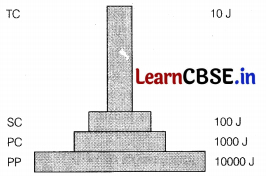
Answer:
Pyramid of energy is always upright because when energy flows from a particular trophic level to the next trophic level, some energy is always lost as heat at each step.
Each bar in the energy pyramid indicates the amount of energy present at each trophic level in a given time.
Question 25.
Discuss the relationship between detritus food chain and grazing food chain in a terrestrial ecosystem. (All India 2012C)
Answer:
The producers occupy the first trophic level in terrestrial ecosystem and thus, make base of food chain. These producers (plants) are grazed upon by the grazers (herbivores). Primary carnivores prey upon herbivores and are eaten up by secondary carnivores.
The decomposers act on all dead animals/plants and return nutrients stored in them to the soil. These nutrients are again used up by the plants and cycle goes on.
This way the grazing food chain and detritus food chain are linked up.
Question 26.
Identify the type of given ecological pyramid and give one example each of pyramid of number and pyramid of biomass in such cases. (All India 2011)

Or
Explain standing crop in an ecosystem. Draw a pyramid of biomass when a small standing crop of phytoplanktons supports a large standing crop of zooplankton in the sea. (Delhi 2010)
Answer:
Given ecological pyramid represents the inverted pyramid of biomass wherein small standing crop of phytoplanktons supports large standing crop of zooplankton.

Pyramid of number is inverted in tree ecosystem and that of biomass in pond ecosystem.
Or
For standing crop in an ecosystem. Refer to Answer No. 2.
Question 27.
Name the type of food chains responsible for the flow of larger fraction of energy in an aquatic and a terrestrial ecosystem, respectively. Mention one difference between the two food chains. (Delhi 2010)
Answer:
Food chain responsible for the flow of large fraction of energy in an aquatic ecosystem is grazing food chain. In terrestrial ecosystem, it is detritus food chain.
Difference between grazing and detritus food chain is as follows
Grazing food chain:
Transfer of energy starts from producers.
Detritus food chain:
Transfer of energy starts from detritus/decomposing organic matter.
Question 28.
‘In a food chain, a trophic level represents a functional level, not a species’. Explain. (Delhi 2016)
Answer:
In a food chain, a trophic level represents a functional level, not a species. It is a specific position of an organism in the food chain. All organisms occupy a particular place in their natural surrounding or in a community according to their feeding relationship with other organisms.
This specific position is based on the organism’s feeding relationship with other organisms and the source of their nutrition or food.
Producers occupy the first trophic level, primary consumers (herbivores) occupy the second and the secondary consumers (carnivores) occupy the third level on the basis of their function in food chain.
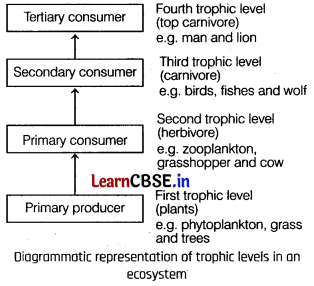
Question 29.
Differentiate between primary and secondary succession. Provide one example of each. (All India 2016)
Answer:
Differences between primary succession and secondary succession are as follows
| Primary succession | Secondary succession |
| It occurs in the bare land. | It occurs in land denuded recently. |
| No soil is present at the time of beginning of primary succession. | Soil is present at the beginning of secondary succession. |
| Humus is absent in the beginning. | Humus is present from the beginning. |
| Pioneer community comes from outside. | Pioneer community- develops partly from previous occupants and partly from migrants. |
| Serai communities are many. | Serai communities are few. |
| It takes a long time for completion, 1000 years or more, e.g. bare land. | It takes less time for completion, 50-200 years, e.g. grass burnt land. |
Question 30.
In a botanical garden of a city there is a huge banyan tree growing on which hundreds of birds and thousands of insects live. Draw the pyramids of numbers and also biomass represented by this community. Comment giving reasons on the two different pyramids drawn. (Delhi 2018C)
Answer:
Pyramid of number and pyramid of biomass showing interaction between trees, insects, birds and big birds is as follows
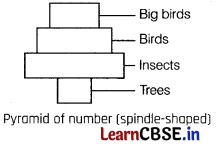
Pyramid of number in this ecosystem is spindle-shaped as the number of insects is maximum. The number of trees and birds are less than the insects. The number is gradually decreasing at each trophic level.
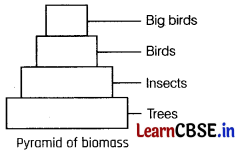
The pyramid of biomass in this ecosystem is erect because the biomass decreases at each trophic level.
Question 31.
What is ecological succession? Where and why would the rate of succession be faster in newly created pond or a forest destroyed by a forest fire? (Delhi 2015C)
Answer:
Ecological succession The sequential, gradual and predictable changes in the species composition in an area are called succession or ecological succession. The entire sequence of communities that successively changes in a given area is called sere (s). The species that invades a bare area and starts the ecological succession are called pioneer species.
Types of Ecological Succession
- Hydrarch succession The plant succession which takes place in wet area or water, leading to a successional series progress from hydric to the mesic conditions.
- Xerarch succession The plant succession which takes place in dry area, leading to a successional series from xeric to mesic conditions.
The rate of succession will be faster in a forest destroyed by fire because here some soil or sediment is present leading to secondary succession while in a newly created pond the succession is primary, therefore, it is slow.
![]()
Question 32.
Explain succession of plants in xerophytic habitat until it reaches climax community. (Delhi 2015C)
Or
Explain, how does a primary succession start on a bare rock and reach a climax community. (Delhi 2012)
Answer:
Primary Succession on Rocks (Xerarch succession)
- Lichens are the pioneer species on a bare rock.
- Lichens secrete acids to dissolve rock, help in weathering and soil formation.
- Later, small plants like bryophytes appear, which hold in small amount of soil.
- Bryophytes are succeeded by bigger plants.
- After several more stages of succession, ultimately a stable climax forest community is formed.
- In this way, xerophytic habitat gets converted into a mesophytic climax community. All successions whether taking place in water or on land, proceed to form a similar mesic climax community.
Question 33.
Differentiate between two different types of pyramids of biomass with the help of an example. (Delhi 2013)
Answer:
Pyramid of biomass refers to the relationship between producers and consumers in terms of biomass. It can be upright, e.g. in grasslands ecosystem or inverted, e.g. in pond ecosystem.
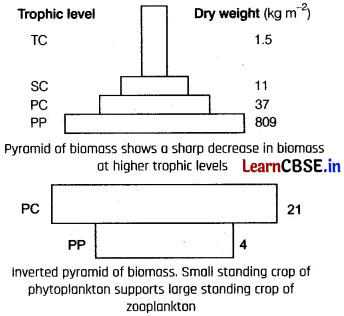
Question 34.
Explain the differences and the similarities between hydrarch and xerarch succession in plants. (Delhi 2011)
Answer:
Differences between hydrarch and xerarch succession are as follows
| Hydrarch succession | Xerarch succession |
| Phytoplanktons are the pioneer species. | Lichens are pioneer species. |
| Initial succession is very fast. | Initial succession is very slow process. |
| It is seen in an area where water is not very deep. | This succession covers the whole area. |
| Climax community develops on the edge only. | Whole area forms the climax community. |
| It converts aquatic environment into mesic environment. | Succession converts xeric environment into mesic environment. |
| It fills up waterbody and changes it into forested land. | It reduces bare land area into fertile forested area. |
Similarity between hydrarch and xerarch succession Both these successions result in medium water conditions, i.e. mesic conditions.
Question 35.
Trace the succession of plants in dry bare rock. (All India 2010)
Answer:
Xerarch succession starts on bare rocks.
For the succession of plants in dry bare rock.
Refer to Answer No. 15.
Question 36.
(i) What is hydrarch succession ?
(ii) Compare the pioneer species and climax communities of hydrarch and xerarch succession respectively.
(iii) List the factors upon which the type of invading pioneer species depend in secondary hydrarch succession. Why is the rate of this succession faster than that of primary succession? (Delhi 2019)
Answer:
(i) Hydrarch succession occurs in wet areas or water, leading to successional series that progresses from hydric to the mesic condition.
| Hydrarch succession | Xerarch succession | |
| Pioneer Species | Phytoplanktons are the pioneer species. | Lichens are the pioneer species. |
| Climax Communities | Climax community develops on the edge. | Whole area forms the climax community. |
(iii) The type of invading pioneer species in secondary hydrarch succession depends on the factor like condition of the soil, availability of water, the environment and also the seeds or other propagules present. The secondary succession is faster than primary succession because it begins in areas where natural biotic communities have been destroyed such as abandoned farm lands, burned or cut forests. Since, some soil is present, succession is faster than primary succession.
Question 37.
(i) The pyramid of energy is always upright. Explain.
(ii) Explain with the help of labelled diagrams the difference between an upright pyramid of biomass and an inverted pyramid of biomass. (All India 2019)
Or
Draw the pyramids of biomass in sea and in a forest. Explain giving reasons why are the two pyramids different ?
Or
It is often said that the pyramid of energy is always upright. On the other hand, the pyramid of biomass can be both upright and inverted. Explain with the help of examples and sketches. (All India 2015)
Or
(i) Draw the pyramids of hiomass in a sea and in a forest. Explain giving reason, why are the two pyramids different.
(ii) Pyramid of energy is always upright. Explain. (Foreign 2010)
Answer:
(i) Pyramid of Energy It represent the total energy of the organism in each trophic level. Pyramid of energy is always upright, i.e., it can never be inverted because when enegy is transferred from a particular trophic level to the next trophic level, some energy is always lost as heat at each step.
(ii) (a) The pyramid of biomass in a sea ecosystem is inverted. Because, the sum total of the weight of phytoplankton (producer) is far less than a few fishes feeding at higher trophic levels.
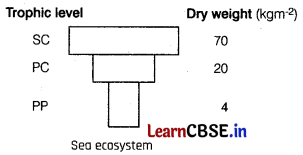
(b) Pyramid of biomass in a forest ecosystem is upright because producers are more in biomass than primary consumers.
Primary consumers are more than secondary consumers and secondary consumers are more than tertiary consumers (top).
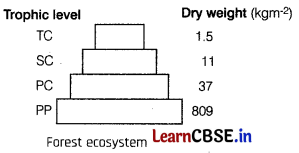
Question 38.
(i) What is a trophic level in an ecosystem ? What is ‘standing crop’ with reference to it ?
(ii) Explain the role of the ‘first trophic level’ in an ecosystem.
(iii) How is the detritus food chain connected with the grazing food chain in a natural ecosystem? (2018)
Answer:
(i) Trophic level Organisms occupy a place in the natural surroundings or in a community according to their feeding relationship with the other organisms. Organisms also occupy a specific place in the food chain on the basis of their nutrition or food. It is known as trophic level.
Standing crop refers to the mass of a living material at a particular time in a trophic level.
(ii) First trophic level consists of producers. These are autotrophs. They trap the light energy and convert it into chemical energy.
The organisms of other trophic levels, i.e. consumers, depend on them for their energy and food requirement. Thus, first trophic level plays a very important role in the ecosystem.
(iii) Connection between grazing food chain and detritus food chain. Grazing food chain and detritus food chain are connected to each other.
Nutrients released by decomposers of detritus food chain are utilised by plants or autotrophs of grazing food chain. These plants in turn transfer these nutrients to other organisms. The dead remains of these organisms are source of food for the decomposers.
Question 39.
(i) What is an ecological pyramid? Compare the pyramids of energy, biomass and number.
(ii) Write any two limitations of ecological pyramids. (All India 2017)
Answer:
(i) Ecological pyramid It is the diagrammatic illustration of connection between different trophic levels in terms of energy, biomass and number of organisms. The base of each pyramid represents the producers or the first trophic level. Apex represents tertiary or top level consumers. In general, all pyramids are upright, but there are few exceptions.
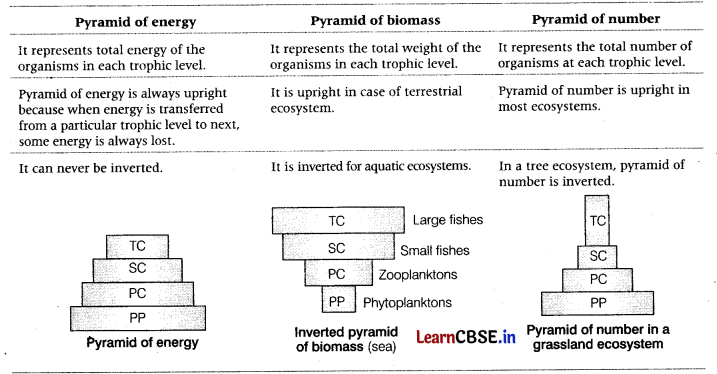
(ii) Limitations of ecological pyramids:
- It never takes into account the same species belonging to two or more trophic levels.
- Saprophytes are not given any place in ecological pyramid even though, they play an important role in ecosystem.
Question 40.
(i) Taking example of a small pond, explain how the four components of an ecosystem function as a unit.
(ii) Name the type of food chain that exists in a pond. (All India 2016)
Answer:
(i) Following are the four components of pond ecosystem which function as unit
- Abiotic (light, temperature, water).
- Autotrophs (producers mainly phytoplanktons).
- Heterotrophs (zooplankton, small fishes, big fishes).
- Decomposers (bacteria, fungi).
Pond ecosystem is self-sustainable unit.
Abiotic components are water, inorganic nutrients dissolved in water, light, temperature. Biotic components are producers like algae and aquatic plants. Consumers are zooplanktons, larvae, tadpole and some fishes. Primary carnivores are water beetles, scorpions, dragonfly larvae, Hydra and some fishes. Decomposers include fungi, bacteria and some flagellates.
This pond system performs all the functions of an ecosystem, which are given below
- Autotrophs They convert inorganic materials with the help of solar energy.
- Heterotrophs They consume autotrophs.
- Decomposers They decompose and mineralise dead organic materials to release them back for reuse by the autotrophs. The above events are repeated again and again.
(ii) Grazing food chain exists in a pond.
![]()
Question 41.
(i) Differentiate between primary and secondary ecological successions.
(ii) Explain the different steps of xerarch succession occurring in nature. (Foreign 2014)
Answer:
(i) For differences between primary and secondary ecological successions, Refer to Answer No. 12.
(ii) For different steps of xerarch succession, Refer to Answer No. 15.
Question 42.
(i) With suitable examples, explain the energy flow through different trophic levels. What does each bar in this pyramid represent?
(ii) Write any two limitations of ecological pyramids. (Delhi 2014C)
Answer:
(i) The energy flows unidirectionally from the first trophic level (producers) to last trophic level (consumers) and as the energy flows from one trophic level to another, some energy is always lost as heat into the surrounding environment. So, the amount of energy flowing decreases at each successive trophic level. This can be explained with the help of a diagram of a grazing food chain. Refer to text on page no. 352.
The pyramid of energy is always upright and each bar in the pyramid indicates the amount of energy present at each trophic level in a given time or per unit area.
(ii) The limitations of ecological pyramids are
- It does not consider the same single species operating at two or more trophic levels.
- It assumes simple food chains that do not exist in nature and do not accommodate food web.
- Saprophytes, detritivores and decomposers are not given any place in pyramids, despite their vital role in ecosystem (any two).
Question 43.
(i) Draw a pyramid of numbers of a situation, where a large population of insects feed upon a very big tree. The insects in turn, are eaten by small birds which in turn are fed upon by big birds.
(ii) Differentiate giving reasons, between the pyramid of biomass of the above . situation and the pyramid of numbers that you have drawn. (Delhi 2012)
Answer:
(i) For pyramid of numbers, Refer to Answer No. 13.
(ii) For differentiation between the pyramid of biomass and pyramid of numbers of given situation, Refer to Answer No. 22(i).
Question 44.
(i) Explain the significance of ecological pyramids with the help of an example.
(ii) Why are the pyramids referred to as upright or inverted? Explain. (All India 2012)
Answer:
(i) Significance of ecological pyramids: They graphically represent the relation between producers and consumers in order to calculate energy content, biomass and number of organisms of that trophic level. A trophic level represents only a functional level not a species as such. A given species may occupy more than one trophic level in the
same ecosystem at the same time. The ecological pyramids provide an overall idea of the trophic levels occupied by an organism in an ecosystem.
Example A sparrow is a primary consumer when it eats seeds, fruits, peas and a secondary consumer when it eats insects and worms.
(ii) Upright pyramids: When producers are more in number and biomass than the herbivores and herbivores are more in number and biomass than the carnivores, pyramids are referred to as upright.
Energy at a lower trophic level is always more than at a higher trophic level. Pyramid of energy is referred to as always upright.
Inverted pyramids When the numbers and biomass of producers are less and consumers increase and become largest in top consumer level, Pyramid of number and biomass is referred to as inverted.
Question 45.
(i) Explain, how a hydrarch succession progresses from hydric to mesic condition and forms from a stable community?
(ii) Why is the rate of secondary succession faster than that of primary succession? (Delhi 2010C)
Answer:
(i) Hydrarch succession occurs in wet areas or water, leading to successional series that progresses from hydric to the mesic condition.
In hydrarch succession, pioneers are phytoplanktons. These phytoplanktons with time are replaced by free-floating angiosperms, followed by rooted hydrophytes, sedges, grasses and finally the trees, leading to mesic condition.
(ii) The secondary succession is faster than primary succession because it begins in areas where natural biotic communities have been destroyed such as abandoned farm lands, burned or cut forests. Since, some soil is present succession is faster than primary succession. At any time during primary or secondary succession, natural and human induced disturbance can convert a particular serai stage of succession to an earlier stage.
Question 46.
Explain how xerarch succession progresses from xeric to mesic condition and forms a stable climax community.
You may use a flow chart. (All India 2010c)
Answer:
Xerarch succession occurs in dry areas and the series progresses from xeric to mesic condition. The climax community remains stable as long as environment remains unchanged. With time, the xerophytic habitat gets converted into a mesophytic one.
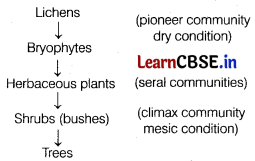
For further detail about xerarch succession, Refer to Answer No. 15.
Question 47.
Mention four significant services that a healthy forest ecosystem provide. (Delhi 2019)
Answer:
Four significant services that a healthy forest ecosystem provide are as follows
- Provisioning services Fruits, vegetables, trees, fishes and livestock are directly available to us by ecosystem. The other benefits in this category are timber, oils, medicines, etc.
- Regulating services These are benefits that moderate natural phenomenon. These include pollination, decomposition, flood control, etc.
- Cultural services It contributes towards the development and advancement of people, e.g. recreation facilities, spiritual healing, etc.
- Supporting services Allow the earth to sustain basic life forms, e.g. photosynthesis, water cycle, etc.
Question 48.
Explain the function of ‘reservoir’ in nutrient cycle. List the two types of nutrient cycle in nature. (Foreign 2o11)
Answer:
Reservoir in an ecosystem meets the deficit that arises due to the imbalance in the rate of influx and efflux of nutrients.
The two types of nutrient cycles are
- Gaseous cycle
- Sedimentary cycle
Question 49.
Name the two types of nutrient cycles exist in nature. Where are their reservoirs present? State the function of reservoirs. (All India 2010C)
Answer:
Two types of nutrient cycles in nature
(i) (a) Gaseous cycles (carbon and nitrogen cycle).
(b) Sedimentary cycles (phosphorus and sulphur cycle).
(ii) (a) Reservoir for gaseous cycle is atmosphere.
(b) Reservoir for sedimentary cycle is earth’s crust.
Function of Reservoir It meets the deficit which occurs due to the imbalance in the rate of influx and efflux of nutrients.
Question 50.
How does phosphorus cycle differ from carbon cycle? (All India 2010)
Answer:
Differences between phosphorus cycle and carbon cycle are as follows
| Phosphorus cycle | Carbon cycle |
| It’s major component is non-gaseous. | It’s major component is gaseous- |
| It’s cycling pool is present in lithosphere. | It’s cycling pool is present in atmosphere and hydrosphere. |
| There is no such biological process involved. | There is respiratory release of CO 2 in atmosphere by living organisms. |
| There is no such exchange. (Any two) | There is exchange of carbon between organism and environment. |
Question 51.
Global carbon is fixed in the biosphere through photosynthesis. Explain any two ways by which carbon is returned to the atmosphere. (All India 2010C)
Answer:
The carbon is returned to atmosphere by two ways
- All living organisms breath and release CO 2 into the atmosphere. So, carbon is replenished in the atmosphere in the form of carbon dioxide.
- Through combustion of the organic matter, the CO 2 is released into the atmosphere. The organic fossil fuels when burn also release CO 2 back to the atmosphere.
Question 52.
(i) State any two differences between phosphorus and carbon cycle in nature.
(ii) Write the importance of phosphorus in living organisms. (Foreign 2015)
Answer:
(i) For differences between phosphorus and carbon cycle, Refer to Answer No. 4.
(ii) Phosphorus is an important component of nucleic acids, biomembranes as phospholipids. It is important element of energy molecule ATP and energy producing ATP systems. In an animal’s body also, its salts are present in shells, bones and teeth. It takes part in metabolic reactions involved in release of energy from food and utilisation of this energy in various functions of the body.
Question 53.
State the function of a reservoir in a nutrient cycle. Explain the simplified model of carbon cycle in nature. (All India 2014)
Answer:
For function of a reservoir in a nutrient cycle.
Refer to Answer No. 2.
For simplified model of carbon cycle in nature. Refer to the diagram on page no. 363 and 364.
Question 54.
Draw and complete the following model of carbon cycle filling A, B, C, D, E and F. (Foreign 2009)
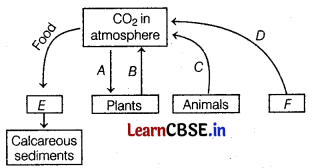
Answer:
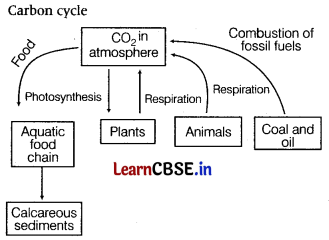
Question 55.
(i) Name the specific cellular components where phosphorus is in abundance in living organisms.
(ii) Name the natural reservoir of phosphorus.
(iii) Explain the phosphorus cycle.
Answer:
(i) Phosphorus is a major constituent of biological membranes, nucleic acids and cellular energy transfer systems.
(ii) The natural reservoir of phosphorus is rock, in the form of phosphates.
(iii) For phosphorus cycle. Refer to text on page no. 363.
![]()
Question 56.
Discuss the role of healthy ecosystem services as a prerequisite for a wide range of economic, environmental and aesthetic goods and services. (Delhi 2017)
Answer:
Ecosystem services are the products of ecosystem processes. Forests are the major source of ecosystem services and are prerequisite for environmental, aesthetic goods and indirect economic values in the following ways
1. Environmental Values:
- Carbon-fixation Huge amount of CO 2 in the atmosphere is removed naturally and fixed by plants into organic molecules and energy through photosynthesis. All the other trophic levels, i.e. consumers depend upon this energy produced by them.
- Release of oxygen by the producers as a byproduct in the process of photosynthesis, improves the air quality and supports life on earth.
- Soil formation and soil protection are the major ecosystem services accounting for nearly 50% of their total worth. Plant cover protects the soil from drastic changes in the temperature. There is little wind or water erosion as soil particles are not exposed to them. The soil remains spongy and fertile. There occurs no landslides and floods.
- Nutrient cycling There is no depletion of nutrients, but the same are repeatedly circulated.
2. Economic Values:
- Ecosystem services provide certain economical important products also. These include timber, paper, rubber, wax, medicines, cosmetics, resins, etc.
- Ecosystem also provides other benefits such as aid in pollination. Bees and other insects of natural ecosystem visit nearby farmlands to pollinate crops.
3. Other Aesthetic Values Natural ecosystems are a source of spiritual, cultural and aesthetic values.
Question 57.
Describe the advantages for keeping the ecosystems healthy. (Delhi 2015)
Answer:
The various benefits that humans obtain from the ecosystem are collectively called ecosystem services.
The advantages of keeping an ecosystem healthy can be grouped into the following types
- Provisioning services Fruits, vegetables, trees, fishes and livestock are directly available to us by ecosystem. The other benefits in this category are timber, oils, medicines, etc.
- Regulating services These are benefits that moderate natural phenomenon. These include pollination, decomposition, flood control, etc.
- Cultural services It contributes towards the development and advancement of people, e.g. recreation facilities, spiritual healing, etc.
- Supporting services allow the earth to sustain basic life forms, e.g. photosynthesis, water cycle, etc.
Question 58.
(i) Draw a simplified model of phosphorus cycle in a terrestrial ecosystem.
(ii) Write the importance of such cycles in ecosystems. (All India 2014C)
Answer:
(i) Refer to figure 14.9 on page no. 363.
(ii) The importance of nutrient cycle in ecosystem can be briefed as
- It allows exchange, storage and transfer of biogenetic nutrients through various biotic components of ecosystem.
- It also allows exchange of nutrients between abiotic and biotic components of ecosystem.
- Recycling of nutrients allows them to be used repeatedly and indefinitely.
Question 59.
Explain the carbon cycle with the help of a simplified model. Delhi 2012
Answer:
For Carbon cycle, Refer to text on page no. 363 and 364.
Question 60.
(i) (a) Name the given biogeochemical (nutrient) cycle.
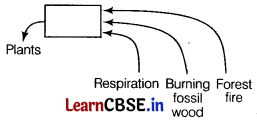
(b) Name an activity of the living organisms not depicted in the cycle by which this nutrient is returned to the atmosphere.
(ii) How would the flow of nutrient in the cycle be affected due to the large scale deforestation? Explain giving reasons. (Delhi 2011)
Answer:
(i) (a) It is a carbon cycle.
(b) Decomposition of organic wastes by decomposers cycles the carbon back into the atmosphere.
(ii) Large scale deforestation will negatively affect the flow of nutrients in the cycle by increasing the level of CO 2 in the air. The CO 2 level will increase because the CO 2 present in the atmosphere will not be fixed by photosynthesis in the absence of plants. Plants annually fix 4 × 10³ kg of carbon through photosynthesis.
If such a huge amount of carbon will not be utilised in photosynthesis, the organism will die at large scale due to lack of food. The decomposition of these dead organisms will further add to amount of CO 2 available in the atmosphere.
Question 61.
Differentiate between standing state and standing crop in an ecosystem. (Foreign 2010)
Answer:
Differences between standing state and standing crop are as follows
| Standing state | Standing crop |
| Amount of nutrients such as nitrogen, phosphorus, calcium, etc., present in the soil of an ecosystem at a given time. | Amount of living biomass available at a given trophic level at a given time. |
| It is an abiotic component. | It is a biotic component. |
Question 62.
(i) Healthy ecosystems are the base of wide range of (ecosystem) services. Justify.
(ii) Explain the differences and the similarities between hydrarch and xerarch successions of plants. (Delhi 2011)
Answer:
(i) Healthy ecosystem provides following ecological services and acts as a base of such services in the following ways
- Purification of air and maintenance of gaseous composition.
- Mitigation of droughts and floods.
- Cycling of nutrients.
- Storehouse of carbon.
- Maintenance of biodiversity.
- Habitat for a number of wildlife.
- Influence on hydrological cycle.
(ii) Differences between hydrarch and xerarch succession are as follows
| Hydrarch succession | Xerarch succession |
| Ecological succession that starts in water bodies and proceeds to mesic condition. | Ecological succession that starts with bare rocks, xeric condition and proceeds to mesic conditions. |
| Phytoplanktons form the pioneer community. | Lichens form the pioneer community. |
Similarities Both hydrarch and xerarch succession lead to mesic conditions.
Question 63.
(i) Trace the succession of plants on a dry bare rock.
(ii) How does phosphorus cycle differ from carbon cycle ? (All India 2010)
Answer:
(i) Primary succession on rocks The organisms that first invade a bare area are called pioneer species. The pioneer species on a bare rock are usually lichens. Lichens secrete acids which dissolve rocks, thereby leading to weathering and soil formation. This paves the way for small plants or bryophytes which hold the soil. They are succeeded by bigger plants and ultimately an entire forest gets established. Forests represent the climax community in this succession.
(ii) Differences between phosphorus cycle and carbon cycle are as follows
| Phosphorus cycle | Carbon cycle |
| It is a sedimentary cycle. | It is a gaseous cycle. |
| Inputs provided by rainfall are very small. | Inputs provided by rainfall are higher. |
| Gaseous exchange between organisms and their environment is negligible. | Gaseous exchange between organisms and environment is high. |
Question 64.
In a food chain, grass is consumed by goat which in turn is consumed by humans. Anant states that man is the secondary consumer in this food chain. Is Anant correct? It yes, give reason.
Answer:
Yes, Anant is correct. In this food chain grass is the producer which feeds energy into the food chain and goat is the primary consumer. Since, goat is eaten by humans, they are called secondary consumers.
![]()
Question 65.
Aryan worked on the farm with his father.
He saw that his father added earthworms to the soil. He came to his father and told him not to do so. His father explained why he was doing so and Aryan was satisfied with the explanation.
(i) Why were earthworms added to the soil?
(ii) What values do you observe in Aryan’s father?
Answer:
(i) Earthworms are detritivores which cause the breakdown of detritus into small, simpler forms. This helps in improving soil quality.
(ii) Aryan’s father is intelligent, hard worker and environment friendly.
Question 66.
Rajni was watching a programme on TV about the earth. The host was explaining how the increased cutting of trees and forests is affecting the ecosystem, its components and services, etc. She got curious and asked her teacher about ‘what services the ecosystem provides to human beings?
(i) How does ecosystem services benefit us?
(ii) Name the value put forth by Robert Constanza and his colleagues on ecosystem services.
(iii) What values are showed by Rajni?
Answer:
(i) Healthy ecosystems provide wide range of economic, environmental, aesthetic goods and services. These services include purification of air, mitigation of droughts and floods, cycling of nutrients, providing habitats for wildlife, maintenance of biodiversity, etc.
(ii) Robert Constanza and his colleagues have estimated the average value of fundamental ecosystem service at US $ 33 trillion a year.
(iii) Values shown by Rajni are awareness and curiosity towards environmental affairs.